Open letter to B C Khanduri, Union Minister of
State for Road Transport and Highways
Dear Transport Minister, you
are holding back state governments from implementing an effective emissions inspection
programme for in-use vehicles in cities. If you fail to act even now when you are
reviewing the ineffectual PUC norms and test procedures to develop an improved emissions
testing system, state governments will be forced to carry on with the charade of PUC
– as in Delhi today. This will only lead to more public harassment with no
improvement in the city’s air.
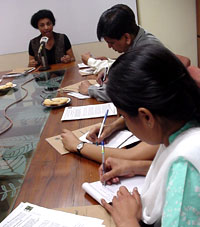 |
| Mr
Minister, give city governments a clear roadmap: CSE |
Dear Shri Khanduri,
We are appalled to note that even 10 years after
introducing the pollution under control (PUC) certificate scheme, your ministry has failed
to evaluate the effectiveness of the scheme. Nor have you charted a roadmap to
improve its efficacy. On the contrary, you have actively encouraged the state governments
to continue this farce -- at huge cost to the exchequer.
Recently, the Delhi
government has announced yet another drive to enforce greater PUC compliance. This is the
only strategy available to the Delhi government to control emissions from a large and
ageing vehicle fleet. City governments are not legally empowered to modify standards
and test procedures that are urgently needed to make the inspection system truly
effective. Setting standards and test procedures is your responsibility – we urge
you to swiftly move towards developing meaningful vehicle inspection procedures.
 |
 |
| Michael
P Walsh & Lennart Erlandsson |
All that the Delhi
government’s current compliance drive will achieve is to equip more than three
million registered vehicles with an ineffectual PUC certificate. The PUC system has only
been given a facelift by adding a few gizmos – a Web camera for automatic imaging of
number plates and computerised data recording that aims to make the system `fool
proof’. But your ministry has never explained how such cosmetic upgrades address the
basic limitations of the current PUC test procedures or overcome the dismally lax
standards designed by your ministry that compromise the quality of tests.
Your ministry’s
standards and test procedures are inadequate, and leave room for manipulation and evasion.
In petrol vehicles, because only carbon monoxide (CO) is measured, anyone can easily
adjust the air-fuel mixture to a lean range in carburetted vehicles to lower CO emissions
to pass the test. Often to manipulate low readings, the measuring probe is not inserted
fully into the exhaust pipe. We were stunned to notice how test booth operators
‘advise’ drivers to beat the system. For instance in diesel vehicles, instead of
rapidly accelerating to full throttle as mandated under the current test procedures, test
operators encourage drivers to accelerate gently and partially to keep smoke readings
within the permitted opacity limit.
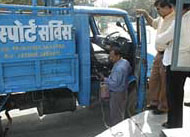 |
| Few commercial diesel vehicles fail the
PUC system |
This is possible because of extremely
inadequate test procedures and in-use standards that have never been changed since 1992.
Worse, the standards are same and lax for all categories of vehicles, irrespective of age
and level of technology. Naturally, vehicles rarely fail PUC tests. In its PUC test data
collected from 13 PUC stations in Delhi from June to August 2002, CSE found that the
average failure rate to be less than 10 per cent. Unbelievably, not a single diesel bus
failed the PUC test, the result of inappropriate testing methods and standards that fail
to detect even the gross polluters.
CSE therefore initiated a technical
evaluation of the entire PUC inspection system. We invited two noted international
experts: Michael P Walsh, a US-based expert who has helped many governments around the
world design strategies to control vehicular emissions; and Lennart Erlandsson of Motor
Test Centre, Sweden, who has been involved in the pioneering work on vehicle inspection to
present a framework of vehicle inspection programme for Delhi. The experts recommended a
phased vehicle inspection plan to replace the ineffectual PUC. CSE has presented this plan
to the Delhi transport minister.
But this plan can only be
implemented if improved test procedures and corresponding standards are immediately
adopted for all vehicles, particularly commercial vehicles and two wheelers.
We would like to bring the
following to your notice:
PUC norms do not vary for different technology levels: The
experts’ study shows that a simple idle test as currently conducted may still
identify malfunctioning systems in carburetted vehicles. But newer cars equipped
with defective electronic fuel injection systems and catalytic converters that cause
higher emissions, will never show up in the current idle CO test. It is therefore vital to
introduce improved test methods for such vehicles (for example, test measurements on high
idle speed or a loaded test).
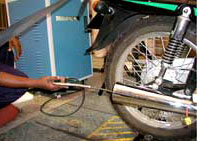 |
| Tailpipery: Probe remains ineffectual |
Appropriate tests have not been designed to measure
particulate emissions from diesel vehicles: The current tests for diesel vehicles do
not adequately measure deadly particulate emissions, of grave health concern in the
city. Evidence shows that the current smoke opacity tests are not representative of
particulate emissions from diesel vehicles. Only loaded mode tests with particulate matter
standards can verify particulate levels. CSE recommends the Ministry of Road Transport and
Highways to immediately develop loaded mode tests conducted on a dynamometer – a
treadmill type of device used to simulate driving speeds on roads to measure emissions.
Without such test procedures, it is not possible to measure other pollutants like NOx and
particulate matter from on-road vehicles.
Even the PUC norms that the ministry is reviewing would require
drastic revisions till the new system is phased-in. Hardly any vehicle will fail the
ministry’s lenient PUC norms: The proposed hydrocarbon norms, for petrol cars
without catalytic converters at 1,500 ppm (parts per million); 750 ppm for those with
catalytic converters; and 9,000 ppm for two-stroke two-wheelers, are too lenient.
Experience with similar technologies in the West shows that idle hydrocarbon emissions
from a petrol car fitted with a catalytic converter must never exceed 100 ppm.
It is meaningless to test only idle emissions without also
measuring key testing parameters to verify the accuracy of the PUC tests: For
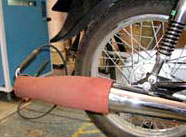 |
| Recommended
test procedure |
instance, measuring oxygen and carbon dioxide in addition
to CO and hydrocarbons will indicate whether the exhaust emissions have been deliberately
diluted by allowing more air at the time of testing. Similarly, measuring the lambda value
(air-fuel ratio) in vehicles with advanced fuel injection systems and catalytic converters
is necessary to check the efficacy of the vehicle’s sensors and catalytic converters.
Similarly, it is important to measure the oil temperature in diesel vehicles to determine
optimal engine temperature for conducting the smoke opacity test.
Consumers will not benefit from the emissions warranty provided
voluntarily by manufacturers if the current PUC system continues: Any vehicle
inspection system should be capable of detecting manufacturing defects in the emissions
control systems, such as in catalytic converters. Only then can we have a successful
manufacturers’ warranty and recall programme. This will also hold manufacturers
accountable.
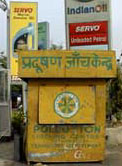 |
| a PUC booth |
State governments have few
strategies available to control emissions from in-use vehicles. The Delhi government has
taken important steps in capping the age of commercial vehicles and converting the old
fleet of diesel buses, three-wheelers and taxis to CNG, which have considerably cleaned
Delhi’s air. But there are still no immediate emissions control strategies for
millions of diesel trucks, commercial vehicles, two-wheelers and diesel cars.
Even the Supreme Court is
pushing the Delhi government towards a better inspection regime. In its July 28, 1998
ruling, the Court mandated the Delhi government to move towards a comprehensive inspection
and maintenance programme. With no improvement in sight, the Court in its February 14,
2003 order directed the Environment Pollution (Prevention and Control) Authority to
examine Delhi’s PUC system. Despite such interventions, the Delhi government has no
legal provisions to establish more efficient emissions norms and test procedures. The
people of Delhi are looking to your ministry to take the lead in this matter.
Mr Minister, don’t let
a fraudulent inspection system cloud our city’s future.
Sincerely,
Right to Clean Air campaign, Centre for Science and Environment
|

